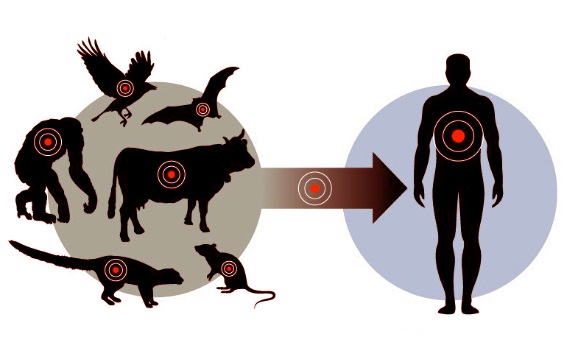Threat from the SARS-CoV-2 JN.1 Variant and Its Sub-Lineages Raises Concerns for Global Health and Animal Transmission
Nikhil Prasad Fact checked by:Thailand Medical News Team Jun 06, 2025 7 months, 2 days, 7 hours, 49 minutes ago
Medical News: Scientists in China and Hong Kong have sounded the alarm over the rapidly spreading Omicron JN.1 variant of SARS-CoV-2 and its sub-lineages, revealing that they have both a dangerous ability to evade human immunity and an increased capacity to infect animals. This means the virus could potentially jump back and forth between humans and animals, increasing the risk of new outbreaks and mutations. The findings come from a team of researchers from multiple leading institutions including the NHC Key Laboratory of Systems Biology of Pathogens at the Chinese Academy of Medical Sciences and Peking Union Medical College, the Department of Microbiology at the University of Hong Kong, and the College of Life Sciences at Peking University.
 Threat from the SARS-CoV-2 JN.1 Variant and Its Sub-Lineages Raises Concerns for Global Health and Animal Transmission
Threat from the SARS-CoV-2 JN.1 Variant and Its Sub-Lineages Raises Concerns for Global Health and Animal Transmission
In this
Medical News report, scientists analyzed and compared how well various Omicron variants—such as XBB.1.16, EG.5.1, BA.2.86, and the newer JN.1—infect different species by testing their spike proteins against ACE2 receptors from 27 animal species. They discovered that JN.1 showed dramatically higher infectivity in animals such as squirrels, rats, foxes, and civets. These animals may now be far more vulnerable to infection than previously thought.
A New Mutation Makes the Virus More Dangerous
The key to JN.1’s increased threat appears to be a single mutation in its spike protein—called L455S. This small change makes the virus more capable of binding to both human and animal cells, and it significantly boosts its ability to fuse with these cells, allowing the virus to enter and infect more easily. Not only that, but the mutation seems to lower the structural stability of the virus's spike protein, making it more ready to "activate" and start an infection once it meets a suitable host.
Even more troubling is that the L455S mutation helps the virus dodge the immune response from earlier infections and vaccines. The study showed that people who had received three doses of inactivated COVID-19 vaccines and were previously infected with earlier variants had almost no neutralizing antibodies against JN.1. However, those who were later infected by XBB variants had much stronger protection—suggesting that current vaccines may need to be updated to include newer Omicron versions like XBB or JN.1.
High Risk of Reverse Zoonotic Transmission
Another major worry is reverse zoonosis, or the transmission of the virus from humans back to animals. The study confirmed that JN.1 can infect a wider range of animal species than previous variants, raising the risk of the virus establishing itself in wildlife. Once in animal populations, the virus could mutate further and potentially spill back into humans in more dangerous forms. In real-world experiments using live virus infections and cell cultures, JN.1 showed higher viral replication and stronger cell-to-cell fusion capabilities compared to BA.2.86.
Stri
kingly, animals such as squirrels, rodents, civets, and foxes showed significantly higher infection rates with the JN.1 variant, while animals like chickens and pangolins were less susceptible. This information is vital for public health surveillance and calls for monitoring wildlife and domestic animals in areas where JN.1 is spreading.
Call for Animal Monitoring
The researchers concluded that the L455S mutation not only enhances infectivity and immune evasion but also expands the virus’s potential host range. This makes JN.1 a serious public health concern, especially in terms of vaccine design and animal surveillance.
Conclusion
This study provides strong evidence that the Omicron JN.1 variant represents a leap forward in the virus’s evolution. It is more infectious, better at evading immunity, and more capable of spreading to animals than earlier variants. The presence of the L455S mutation appears to be the primary driver of these changes. The ability of JN.1 to infect animals raises fears of the virus hiding in wildlife reservoirs, where it could mutate further and potentially start new outbreaks. In light of these findings, global health authorities should step up surveillance in both human and animal populations.
The study findings were published in the peer reviewed journal: iScience
https://www.sciencedirect.com/science/article/pii/S2589004225010855
For the latest COVID-19 News, keep on logging to Thailand
Medical News.
Read Also:
https://www.thailandmedical.news/news/sars-cov-3-new-coronavirus-strain-from-pigs-shows-ability-to-alter-human-genes-and-raises-fears-of-zoonotic-threat
https://www.thailandmedical.news/news/sars-cov-3-that-is-likely-to-debut-in-2025-will-involve-a-recombinant-porcine-delta-coronavirus-strain-and-not-bat-viruses
https://www.thailandmedical.news/news/newly-identified-rotavirus-genotype-in-mexico-raises-zoonotic-concerns
https://www.thailandmedical.news/pages/thailand_doctors_listings
https://www.thailandmedical.news/articles/hospital-news
